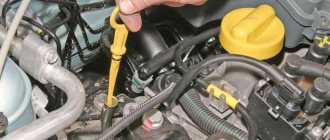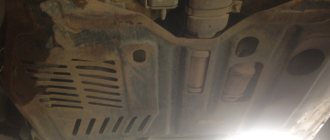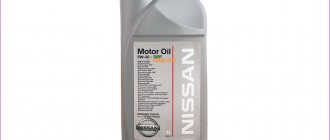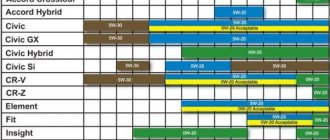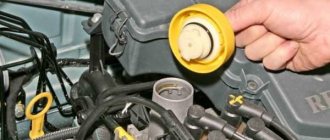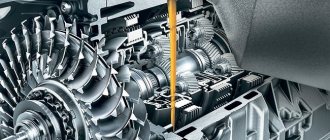Regular oil changes in Nissan cars will guarantee trouble-free operation of the vehicle engine. It is necessary to change the oil in full accordance with the manufacturer's requirements, using high-quality technical fluids for this work. It should be said that such service work is not particularly difficult, so you can easily perform it yourself, which will allow you to significantly save on the use of service station services. Let us tell you in more detail how to change the oil in a Nissan Almera Classic.
What kind of oil to pour
In accordance with the recommendations of the car manufacturer, it is necessary to perform such service work at intervals of 10-15 thousand km, changing the oil and the corresponding filter element.
First of all, the car owner, if he plans to perform such work on his own, needs to select the lubricant used. We can recommend for Almera and Nissan Qashqai semi-synthetic Shell with a softness rating of 5w-30 or original oil, which can be easily purchased at most specialized auto stores. You will also need to use the appropriate filter element.
Remember that you need to choose a filter taking into account the specific generation of the car and the engine installed on it. It is best to purchase an original filter, which will completely eliminate future problems with cleaning the lubricant used.
Oil selection
On the primary and secondary markets and in the ownership of Russian motorists, you can find two generations of Japanese crossover models - the first (J10) and the second (J11). Moreover, the J10 can be equipped with gasoline-powered units with a volume of 1.6 liters or 2.0 liters or a diesel engine of 1.5, 1.6 or 2.0 liters. Moreover, when choosing a lubricant for gasoline engines, you should pay attention to the standards. According to ACEA this can be A1/B1, A3/B4, A3/B3 or A5/B5. According to API - SM or SL with an acceptable viscosity of 5W-30. The amount of fluid for the 1.6-liter power unit is 4.3 liters. If there is a 2.0 engine - 4.4 liters. If you do not need to change the filter, the volumes are reduced to 4.1 and 4.2 liters, respectively.
If the vehicle is equipped with a 1.5-liter engine running on diesel fuel, you should choose oil with the ACEA index A1/B1. Volume – 4.6 or 4.4 liters, depending on whether the filter is also changed when filling. For power units with a volume of 2.0 liters, oils with index B are suitable, and its quantity is 7.0 or 7.4 liters. You can lubricate a 1.6 liter engine with a fluid marked C4 (5.5 liters when replacing the filter or 5.1 liters if without). Nissan branded lubricant is also suitable for all units.
The J11 is equipped with 1.2 and 2.0 liter gasoline engines. A3/B4 or Nissan grease with a viscosity of 5W-40 is suitable for everyone. For the “younger” version, 4.63 or 4.3 liters is enough with or without replacing the filter element. For the second version of the unit – 4.4 or 4.2 liters, respectively.
If the same car is equipped with an engine that runs on diesel fuel, the lubricant parameters should be C4 according to ACEA and 5W-30. The volume of lubricant for the only diesel engine in this version of the car is 5.5 liters with a complete replacement,
Where to pour oil
The oil filler neck is located directly on the valve cover. In most models, you can find such a neck, closed with a plug, by simply opening the hood of the car. However, in some modifications and in new Nissans, the motors are covered with plastic.
Therefore, it will be necessary to unscrew the screws that secure such protective plastic, after which the car owner will have access to the oil filler plug in the Nissan. You can easily open such a plug manually without using any additional tools.
Where is it located and how to replace it
Where is the oil filter located in Nissan Almera? It is convenient to access it from below using the inspection pit. If necessary, unscrew the protection. You cannot unscrew the filter housing by hand. You need a special puller that covers the filter housing or key. The replacement steps are as follows:
- A Nissan Almera classic 2007 (for example) is rolled into a pit;
- They go downstairs, grabbing the keys and a container for working off;
- Work with gloves, drain the oil on a hot engine;
- If necessary, the protection is unscrewed;
- If you are going to flush the system, first flush with oil and let the engine run for 10 minutes;
- Open the oil filler cap to allow air access;
- The drain plug is unscrewed and the oil is drained into the container;
- After this, the filter is unscrewed using one of the devices listed above;
- Wipe the seat under the filter with a rag;
- Before screwing on the new filter, you should pour 50-100 grams of fresh oil inside it and lubricate its O-ring with oil;
- Oil is poured in for a reason, but to reduce the time the parts rotate dry until the lubricant disperses throughout the system and reaches the filter;
- If you do not lubricate the sealing ring, it may be turned out of the groove when tightened, and then the oil will flow past as soon as you start the engine;
- The filter is screwed in only by hand until it stops; using keys is not advisable; if everything is done as needed, oil will not flow from under it;
- Tighten the drain plug (every third car enthusiast forgets about this);
- Only after this, new oil is poured according to the dipstick level, the norm is in the middle, between the minimum and maximum marks;
- Start the engine for 5 minutes, then wait another 5 minutes for the oil to drain;
- Check its level using the dipstick (checking the level is carried out on a level surface, do not forget about this; on an uneven surface you will see the level is incorrect, and underfilling of lubricant means premature wear of the motor; overfilling will cause the lubricant to be driven through the seals);
- After making sure that there are no drips and adding grease to the level, you can screw the protection back if it was removed;
- If drips appear, you should tighten the drain plug and filter (but without fanaticism, you can turn off the thread);
Do not forget about safety measures, the oil is hot and so is the engine, you can get burned if you are careless. Getting dirty with oil is also unpleasant; it is extremely difficult to wash off, so the work is done in clothes that you don’t mind throwing away.
Engine flushing
If the engine has already run more than two hundred thousand kilometers and is operated in difficult conditions, or you are not sure of the quality of the lubricant that the previous owner of the car used before you, then we can recommend performing the engine flushing procedure with special compounds. The same cleaning chemicals are used in Nissan Qashqai; they can be purchased at most specialized stores.
Flushing is carried out as follows:
- Immediately after draining the old oil in a Nissan, you need to tighten the drain plug, pour the required amount of flushing fluid into the engine in accordance with the instructions, start the engine and let it run for 5-10 minutes.
- Next, turn off the engine, wait for the flushing oil to cool, then drain it, then change the filter and fill in new lubricant.
It is recommended to carry out a similar procedure with a car engine every 100 thousand kilometers. Such flushing will allow you to get rid of carbon deposits in the engine, and all blockages in the oil channels that can become clogged with coking oil will be eliminated.
After how many km should you change the engine oil?
Many car owners do not know how often to change the oil in their car’s engine or doubt the data provided by the manufacturer on the frequency of replacing consumables. And for good reason. Replacement every 10-15 thousand kilometers is often not entirely correct. It is better to be guided by the number of engine hours worked and the average speed. There are many components to the answer to the question of how often to change engine oil. Among them are the recommendations of the car manufacturer, operating conditions of the car (heavy/light, in the city/on the highway, often/rarely used), mileage before oil change and total mileage, technical condition of the car, oil used, and so on.
Also, the frequency of engine oil changes is influenced by additional factors - the number of engine hours, engine power and displacement, time since the last oil change (even without taking into account the operation of the machine). Next, we will tell you in detail about how often to change the engine oil, what it is like, and other things that will probably be useful to you.
For those who do not want to go into details and understand everything in detail, we will immediately give an answer regarding the change interval: in urban conditions, the oil “works” for 8-12 thousand, on the highway/light driving mode without traffic jams it lasts up to 15 thousand km. The most accurate way to find out when to change it can only be obtained from a laboratory analysis of the oil used.
Step-by-step instruction
It is necessary to change the engine oil with a warm engine, which will ensure good fluidity of the oil, and the car owner will be able to completely drain the lubricant by opening the drain plug. Therefore, you can warm up the car by driving the car for a few minutes or first start the engine and let the engine idle for about 5 minutes.
- The entire procedure is carried out on an overpass, a lift or in a garage pit. Therefore, we drive the car onto a lift and warm up the engine.
- The crankcase protection prevents access directly to the drain plug. We unscrew the crankcase protection bolts, for which we use a 14mm wrench. You only need to unscrew a few bolts.
- We unscrew the filler cap by hand. If it is covered with plastic panels, you need to unscrew the self-tapping screws with a Phillips screwdriver, which will allow you to gain access to the filler neck. You will see a drain plug in the oil pan. We place a container under this drain plug to drain the old oil and unscrew the bolt with a 14mm wrench. We wait until the old lubricant is completely drained, which takes about half an hour.
- At the next stage of work, the filter element is replaced. You can unscrew the filter manually using a puller, or if the thread is burnt, then pierce the body of such a filter element with a flat screwdriver. Using it as a lever, you can tear off the burnt threads.
- Next, pour a small amount of fresh oil into the new filter and carefully screw it onto the threads by hand.
- We tighten the drain plug and install the crankcase protection in place.
- Next, carefully use a funnel to pour about three liters of lubricant into the engine through the upper hole. Then we start the engine and let it run for about 2-3 minutes.
- We turn off the engine and wait about 10 minutes until the oil drains into the crankcase, after which we check its level using a dipstick. If necessary, add fluid to the motor so that its mark is exactly halfway between the maximum and minimum levels.
At this point, all work is completed and you can easily use your car. Work is carried out in a similar way at Nissan Qashqai.
Instructions for changing oil without changing the type of oil on Nissan
- Remove the plastic protection on the engine called the motor cover. This will give you access to the traffic jam.
- Unscrew the cap from the engine crankcase filler hole.
- Remove the plug in the oil pan and drain the old oil. Prepare a container in advance where the oil will be drained. Volume of at least 3 liters. The oil should drain completely until it stops dripping.
- At this step, you need to replace the oil filter.
- Tighten the drain hole in the pan after the oil has drained. Before doing this, wipe the drain hole with a rag and be sure to replace the copper O-ring.
- Pour new oil into the filler hole.
- Screw on the filler cap.
After the work has been done, warm up the engine. Check if oil is leaking from anywhere. Oil may leak around the drain hole or oil filter. If everything is in order, then turn off the engine and wait 10 minutes. After a while, check the oil level with a dipstick. The oil level should be between the MIN and MAX marks
Photo of the oil change process on a Nissan NoteUnscrew the cap from the filler hole of the Nissan Note: We unscrew the plug to drain the old oil (don’t forget to place a container into which the oil will drain): This is what the O-ring looks like, which seals the drain hole. When changing the oil, this ring also changes: Unscrew the old oil filter: We take the new filter out of the box, fill it with oil and lubricate the threads with oil: Then screw the filter into place. We tighten the drain hole and fill in new oil, checking the level with a dipstick. | Photo of the oil change process on a Nissan QuashqaiUnscrew the filler cap on the Nissan Qashqai: Unscrew the drain plug. Replace the copper o-ring on the plug: Remove the plastic protection to get to the oil filter: We unscrew the old oil filter and replace it with a new one. First wipe the hole where the filter is screwed in with a rag. Lubricate the filter threads with engine oil. Screw in the new filter: We tighten the drain hole, put back the plastic protection and fill in new oil. Checking the oil level with a dipstick. The level should be between the MIN and MAX marks. Close the filler neck. After this, start the engine. After 5 minutes, turn off the engine and check the oil level again with the dipstick. |
Changing the oil on other Nissan car models follows a similar principle.




